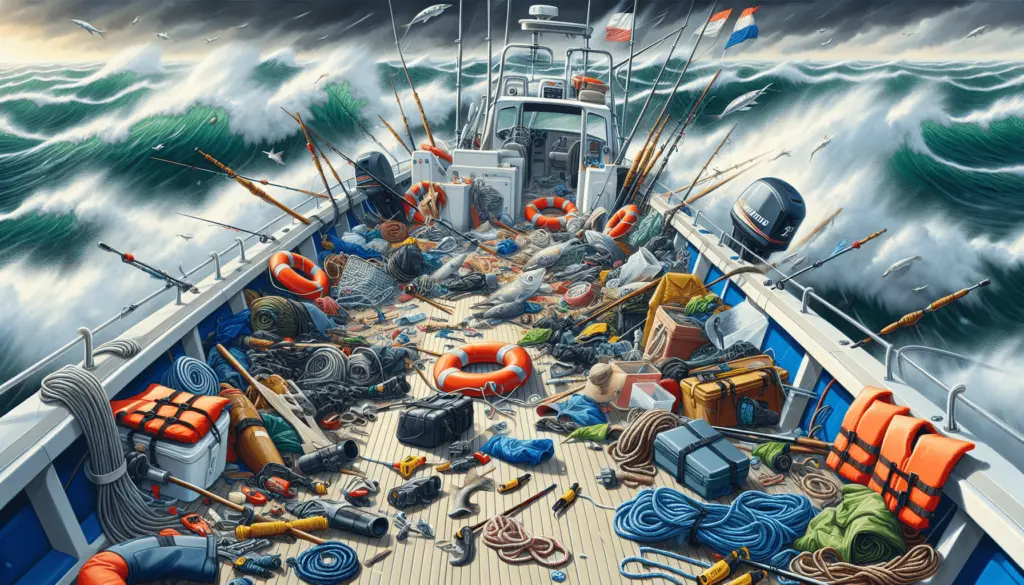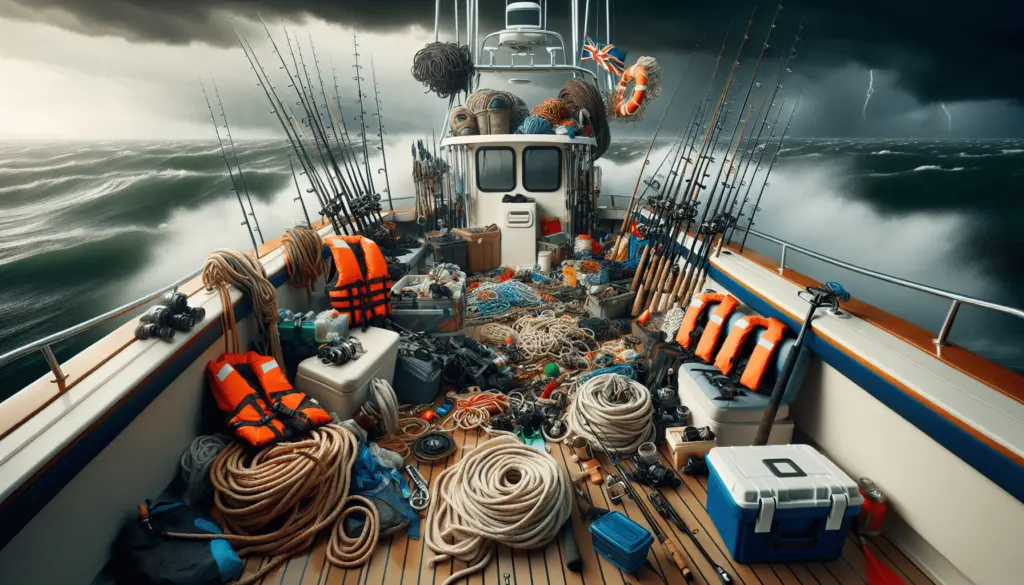Imagine the rolling waves, the vibrant sun, and the salty breeze of the open sea, but suddenly your tranquillity is disrupted by the clattering of loose equipment on your boat. In this initiative, “How To Secure Loose Gear On Your Boat,” you’re embarking on a journey to master the art of keeping your equipment steady even when nature refuses to keep calm. Expect to navigate through practical tips, expert advice, and proactive measures to help you secure your belongings effectively on your boat, ensuring a smooth and stress-free sailing trip.

Understanding the Importance of Securing Loose Gear
As the sun sets over sparkling waters and your boat gently rides the waves beneath an opalescent sky, there’s an undeniable sense of peace and freedom. However, caution must ride with you on these serene voyages. Ensuring the safety and security of loose gear is paramount, not just for the safety of the boat, but also for your well-being.
Potential dangers of loose gear
Imagine you’re navigating through choppy waters, and a rogue wave hits. If your gear isn’t securely fastened, it can swing wildly, causing damage and potentially injuring you or your crew. Loose gear can become hazardous projectiles, threatening those on board; it can jam vital machinery or even be lost overboard.
How loose gear affects boat balance and performance
In addition to presenting danger, loose gear can significantly affect your boat’s balance and performance. The physics of sailing demand an even weight distribution for optimal performance. Erratic movement of unsecured items can negatively impact your boat’s stability, speed, and maneuverability.
General rules for securing gear
Remember, everything onboard that isn’t nailed down should be stowed. Keep heavy objects low and centered in your vessel to maintain stability. Regularly secure and check equipment for signs of loosening. And never forget: safety first!
Use of Storage Lockers and Compartments
A well-organized boat isn’t just pleasing aesthetically; it can also be a matter of safety, as items stowed haphazardly can become hazardous in choppy waters or during sudden maneuvers.
Ideal storage spaces on a boat
Lockers and compartments are ideal storage spaces on a boat. They truncate the travel distance a loose object can cover, minimizing the risk it poses.
Proper utilization of storage lockers
Lockers and compartments should be used wisely– weighty items should be stored in lower compartments, with lighter items taking the higher spaces. Suitably fitted nets or doors on these storage spaces prevent objects from being dislodged during movement.
Keeping items organized within compartments
To maximize your boat’s efficiency and safety levels, it’s wise to keep items organized within compartments. Use dedicated storage solutions like bins and organizers that you can secure, allowing for easy access and minimizing risk.
Strapping Down Gear to the Deck
For certain types of equipment, you may need to have them out on the deck. However, to prevent them from becoming dangerous projectiles, they must be properly strapped down.
Selecting appropriate straps
The first step is selecting straps suitable to withstand harsh marine conditions. They should be tough and durable, yet gentle on your gear—elastic cords and marine grade straps are often a good choice.
Creating secure tie-down points
Ensure you’re affixing your gear to secure tie-down points. These could be factory-made points, such as cleats or winches, or custom-installed eyes.
Proper strapping techniques to ensure gear doesn’t shift
Achieving secure fixation requires employing the correct strapping techniques—cross or diagonal strapping generally provides the best stability.
Utilizing Netting for Additional Storage
Netting offers an excellent storage solution, allowing items to be secure, within reach, and easily visible.
Benefits of using netting
Netting helps utilize vertical space on a boat, provides easy access, and increases the functionality of your craft. It keeps items in plain sight, which can be hugely beneficial during emergencies.
How to install boat netting
Installing netting is a straightforward process. Identify an appropriate space, assess the dimensions, cut and hem the netting, then attach it securely.
Securing items within the netting
While netting can hold items effectively, take care to ensure sharp objects or heavy gear aren’t stored in nets. Use carabiners or hooks to secure items that might slip through.

Securing Fishing Equipment
Fishing equipment presents its unique challenges. Long and unbalanced, rods and reels can quickly become hazardous if unsecured.
Good practices for securing rods and reels
Investing in dedicated rod holders is a good practice. Not only do they secure rods and reels, but they also provide easy access when a fish is biting!
Storage options for fishing bait and tackle
Bait and tackle are best stored in specialized containers. These allow for easy access, prevent items from getting damaged, and stops hooks from becoming dangerous loose items.
Keeping fishing equipment safe from saltwater damage
Rust and corrosion can damage your fishing equipment. Washing your gear with fresh water after each use and storing it in a cool, dry place can increase their lifespan.
Safety Precautions for Electronics
In this era, sailing without electronic navigation and communication equipment would be unthinkable. However, these tools require dedicated care and attention.
Proper storage of navigational equipment
Navigational equipment should be installed in a space easily accessible from the helm, yet shielded from elements.
Protecting electronic devices from moisture
A boat is an inherently damp environment. Utilizing waterproof covers and enclosures for your devices will protect them against moisture and increase their longevity.
Securing electronics for bumpy water conditions
Despite their weight, electronics need to be secured for rough water conditions. Using mountings, braces, or holders can ensure your precious devices don’t take an unintended plunge.
Securing Loose Objects Inside the Cabin
The inside of the cabin is often overlooked when it comes to securing loose items. Yet, the dangers they can pose are just as significant.
Identifying potential hazards in the cabin
Books, bottles, plates: all these need to be stowed safely or secured using nets, cargo bars or other solutions. Even furniture can pose a risk if not appropriately secured.
Securing items on shelves and countertops
Shelf lips, non-slip mats, and other securing methods can prevent everyday items from becoming hazardous in rocky conditions.
Keeping cabin furniture from shifting during movement
Couches, tables, and chairs are weighty items that can seriously harm crew members if they shift. Ensuring furniture is anchored, or bolted down to the cabin’s structure, will prevent this.
Securing the Dinghy and Other Towed Equipment
Towed equipment, like a dinghy, whether carried on deck or towed behind, must be secured properly to prevent loss and damage.
Importance of a secure dinghy tow system
A secure tow system prevents the dinghy from flipping, filling with water, or even detaching and becoming lost at sea.
Techniques for tying down towed equipment
Crisscross strapping, using chafe guards on lines where wear is likely, and securing multiple attachment points ensures your towed gear stays put.
Regularly inspecting tow systems and equipment for safety
Routine inspections of line connections, fastening points, and the general condition of the towed equipment are vital to maintaining overall safety.
Maintaining Your Boat’s Equipment Security
Just as the sea is ever-changing, the equipment on your boat will age and wear. Regular checks and maintenance can prevent equipment failure at the worst possible times.
Regularly inspecting equipment for signs of wear and tear
Regularly inspect your securing equipment for sings of corrosion, fraying, or any other damage. Don’t wait for failures; be preventive.
Revising gear securing systems every season
Revise your securing systems each season. Adjust and improve on your techniques, replace worn-out gear and consider new solutions for new gear.
Keeping a checklist for boat safety
A boat safety checklist can be a lifesaver. Regular use encourages a thorough safety overview and becomes a reminder for tasks that might otherwise be overlooked.
Emergency Preparedness and Gear Security
Securing your gear doesn’t end with making sure it doesn’t fly off the boat. Certain equipment must be readily accessible in case of emergencies.
Having a plan for sudden weather changes
Understanding weather patterns, keeping abreast of forecasts and having a plan for sudden changes enables you to secure loose gear quickly and effectively when needed.
Keeping emergency equipment easily accessible
Emergency equipment like fire extinguishers, life rafts, and EPIRBs need to be accessible immediately. Ensuring these are securely but quickly reachable could be a matter of life and death.
Storing and securing lifejackets and other safety equipment
Life jackets and safety harnesses should be stowed in an area that’s easy to access in a hurry, yet they must also be stored in a way that they remain secure and don’t become hazards themselves.
In conclusion, while the safety of securing loose gear might seem tedious or unnecessary in calm waters, remember that the sea is an unpredictably dynamic environment. By implementing these tips and techniques, you’re not only keeping your gear safe—you’re ensuring the safety and well-being of everyone on board and helping to maintain the integrity and performance of your beloved boat. Stay secure and enjoy safer voyages on the briny blue.

